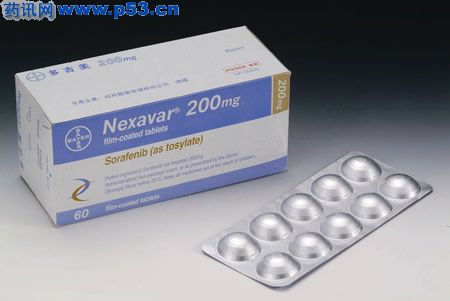|
导读:多吉美-晚期肾癌首选的治疗药物,是一个双通道、多靶点的多激酶抑制剂,用于治疗晚期肾癌患者,显示出重要的抗肿瘤活性. 多吉美是一种新型的治疗晚期肾癌的小分子口服多激酶抑制剂,其主要成分是索拉非尼甲苯磺酸盐,该成分在临床前研究中显示了抗血管生成及抗细胞增殖的活性。2005年,多吉美作为10余年来首个被批准治疗晚期肾癌的新药上市,目前已在60多个国家获准用于该适应症的治疗。 作用机理 服用方便快捷 安全性及耐受性 临床疗效
Developed by Bayer Pharmaceuticals & Onyx Pharmaceuticals Nexavar Belongs to a New Class of Cancer Drugs, Referred to as Anti-Angiogenic Drugs or Angiogenesis Inhibitors. The Anti-Cancer Agents Prevent The Metastasis of Cancer Cells and Enhance the Effectiveness of Chemotherapy. The Newly-Authorized Drug Became the Second Angiogenesis Inhibitor Available for the Treatment of Cancer. (Avastin was the first anti-angiogenic drug to reach the market, receiving approval for the treatment of colorectal cancer in 2004). Ongoing research trials are now evaluating Nexavar in the treatment of a broad range of cancers. The cutting edge drug is now being assessed in the treatment of melanoma and lung, prostate and thyroid cancer. New Alternatives for Kidney Cancer Treatment Targeted Cancer Drugs Have Produced a Major Advance in the Treatment of Advanced Kidney Cancer. Conventional Cancer Treatments Have Rarely Been Effective, Resulting In A Five-Year Survival Rate of Less Than 10 Percent. Kidney Cancer is Highly Resistant To Chemotherapy, and Only Five to 10 Percent of Patients have Responded to Interferon Alfa, an Immune System Stimulant. Six Targeted Drugs Are Now Available for the Treatment of Inoperable Kidney Cancer; Afinitor, Avastin, Nexavar, Sutent, Torisel and Votrient. Clinical Research Trials Have Not Yet Determined Which Targeted Drug, or Combination of Drugs, is Most Effective in The Treatment of Advanced Kidney Cancer. Ongoing Research Trials Are Comparing the Effectiveness of Newly-Approved Targeted Drugs. Combinations of Targeted Drugs Also Are Under Evaluation. Nexavar Belongs to a New Class of Cancer Drugs, Referred to As Anti-Angiogenic Drugs or Angiogenesis Inhibitors. The Development of Anti-Angiogenic Drugs Ranks Among the Most Significant Recent Advances in Cancer Research And Treatment. Nexavar Became the Second Angiogenesis Inhibitor Available for the Treatment of Cancer. (Avastin was the First Anti-Angiogenic Drug to Reach the Market, Receiving Approval for the Treatment of Colorectal Cancer in 2004). Anti-Angiogenic Drugs Such As Nexavar Differ Radically from Conventional Cancer Treatments. Unlike Chemotherapy and Radiation, Anti-Angiogenic Drugs Do Not Directly Induce the Death of Cancer Cells. Instead, the Newly-Developed Drugs Halt the Process That Allows Cancer Cells to Metastasize. The New Class of Cancer Drugs Prevents the Formation of Blood Vessels, a Process Referred to as Angiogenesis. Without the Development of New Blood Vessels, A Tumor Cannot Grow Beyond The Size of One to Two Millimeters in Diameter. The development of angiogenesis allows tumors to receive the Oxygen and Nutrients Necessary for their continued growth. The Formation of new Blood Vessels also Enables Cancer Cells to Escape into the Circulation. Nexavar Inhibits the Production of Proteins that Stimulate Angiogenesis. The Anti-Cancer Agent Targets Vascular Endothelial Growth Factor Receptor (VEGFR) and Platelet-Derived Growth Factor Receptor (PDGFR). Blocking these Receptors Restricts the Production of VEGF and PDGF, Thereby Limiting the Development of new Blood Vessels. Authorized Uses Nexavar Was Approved for the Treatment of Advanced Renal Cell Carcinoma, The Most Frequently-Diagnosed form of Kidney Cancer, on December 20, 2005. The Targeted Drug Was Authorized For The Treatment of inoperable Heptocellular Carcinoma, The Most Common Form of Liver Cancer, on November 16, 2007. Research Findings: Phase III Trial An International Research Trial Demonstrated that Nexavar Delayed the Progression of Kidney Cancer, But Did Not Significantly Extend Survival. The Food and Drug Administration approved Nexavar on the basis of an interim analysis, issued in January, 2005. The analysis indicated that treatment with Nexavar nearly doubled the time until cancer progressed. The median progression-free survival was 5.5 months for patients treated with Nexavar, versus 2.8 months for patients who received a placebo. A Subsequent Analysis, published in the New England Journal of Medicine on January 11, 2007, reported that Nexavar extended survival by almost four months. However, the increase in the Length of Survival was Not Considered Statistically Significant. Research Findings indicated That the median overall survival of patients treated with Nexavar was 19.3 months. In Comparison, the Median Survival of Patients Who Received a Placebo was 15.9 Months. Treatment with Nexavar also produced higher response rates. Nexavar produced complete remission in one patient, and partial remission in 10 Percent of patients. Another 74 percent had no progression of cancer, referred to as stable disease. No patient who received a placebo entered complete remission, and two percent developed partial remission. Stable disease was reported in 53 percent. Side Effects Nexavar was generally well-tolerated by patients enrolled in the Phase III clinical trial. Research findings, which were published in the New England Journal of Medicine in January, 2007, concluded that Nexavar produced "moderate and easily manageable toxic effects." Severe Complications of Nexavar included Cardiac Ischemia and Myocardial Infarction. In The Phase III Clinical Trial, Three Percent of Patients Suffered Cardiac Ischemia, The Disruption of Blood Flow To the Heart By The Blockage of a Coronary Artery, or Myocardial Infarction, A Severe Blockage That Results in a Heart Attack. Trial Investigators Concluded that "the Overall Rate of These Events was Low, and the Risk-Benefit Ratio was Acceptable in the Context of an Apparent Clinical Benefit in Patients with a Fatal Disease." The Most Common Side Effects Were Diarrhea, Rash, Fatigue, Hand-Foot Skin Reaction, Hair Loss and Nausea. Complications were Predominantly Classified as Grade 1 or 2, the Least Severe. Research Study: Risk Of Hypertension A Research Study Published in Lancet Oncology concluded that Nexavar significantly increased the risk of hypertension The Study, Published in the February, 2008 Issue, Found that Patients Treated with Nexavar had Six Times the risk of developing hypertension. Research Findings Indicated that high Blood Pressure Developed in 23.4 percent of Patients who received Nexavar. High-grade Hypertension (classified as grade 3 or 4) was Reported in 5.7 Percent of Patients. The Research Study, Conducted by Investigators from the State University of New York at Stony Brook, evaluated Data from Nine Clinical Trials. The Research Trials Evaluated Nexavar in the Treatment of Kidney, Liver and Prostate Cancer, as well as Melanoma. |
多吉美(甲苯磺酸索拉非尼片)-晚期肾癌首选的治疗药物简介:
导读:多吉美-晚期肾癌首选的治疗药物,是一个双通道、多靶点的多激酶抑制剂,用于治疗晚期肾癌患者,显示出重要的抗肿瘤活性.
多吉美是一种新型的治疗晚期肾癌的小分子口服多激酶抑制剂,其主要成分 ... 责任编辑:admin |
最新文章更多
推荐文章更多
热点文章更多 |



